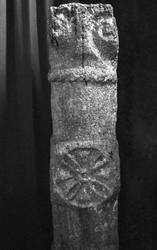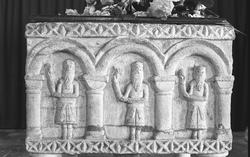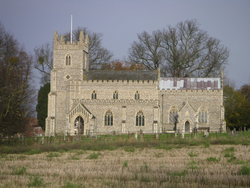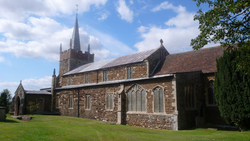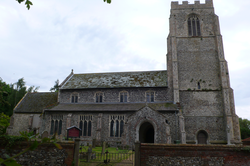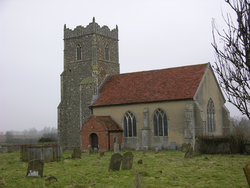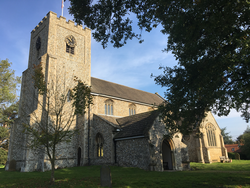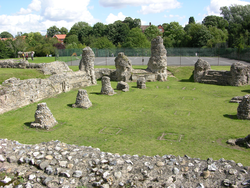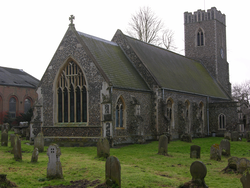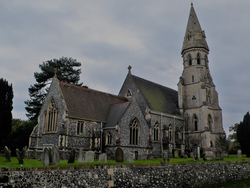
The Corpus of ROMANESQUE SCULPTURE in Britain & Ireland
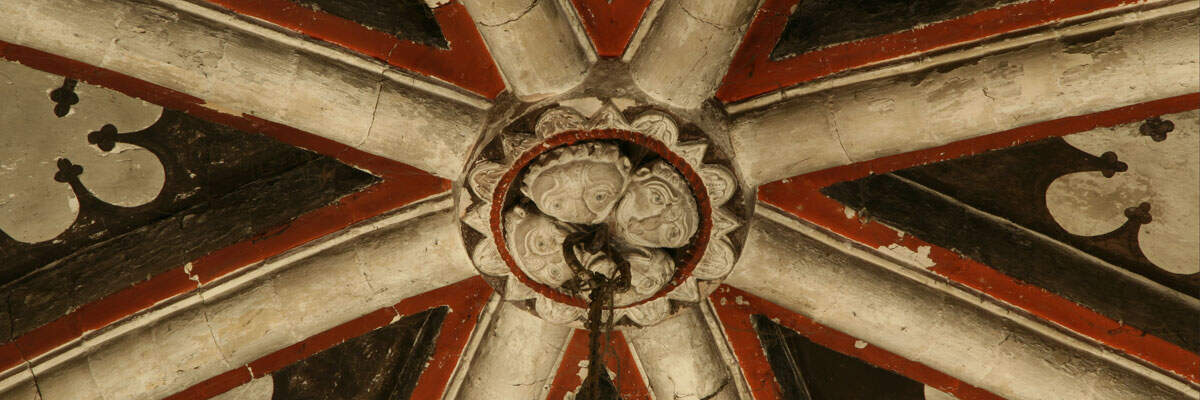
North Elmham (c.950-1071), Thetford (1071-94), Norwich (from 1094) (medieval)
Parish church
Great Moulton is a vilage in Norfolk, located about 10 miles SSW of Norwich. The church of St Michael was rebuilt in 1887 but the Romanesque tower arch and imposts survive, as does the coursed flint masonry of the chancel and nave, bearing traces of round-headed windows. The fragment of a decorated colonnette is the only Romanesque sculpture observed at the site. It may have come from a window, as with the similar example in situ at St Mary Magdalene, just outside the centre of Cambridge.
Parish church
Fincham is a village in the King's Lynn and West Norfolk district, ten miles S of King's Lynn. The church stands in the village centre, and is an imposing mid-15thc building of flint and carstone with ashlar dressings, consisting of a 5-bay aisled nave with a S porch, a chancel and a 3-stage W tower. The only Romanesque feature is an early-12thc font, brought to St Martin's from the former church of St Michael, Fincham, a 12th and 13thc church demolished in the mid-18thc.
Parish church
St Mary's was built 1n 1866-8, following the design of the medieval building it replaced. It retains an elaborate Easter Sepulchre of c.1500 installed by the Townshend family of local and national significance. The spiral shafts described here constitute the only Romanesque sculpture at the site.
Parish church
Almost nothing earlier than its 13thc W tower is visible at St Edmund's, a striking building constructed of a combination of dark local carstone and even darker ferrugious conglomerate. In its present state, it dates from the 13th-15thc with much 19thc restoration in places. It has a chancel, an aisled nave and a N transept but there are also signs of a former S transept, indicating that the previous building on the site was cruciform. The small colonnette reset in a puropse-built recess in the external N wall of the N transept presumably came from an earlier church and is now the only Romanesque sculpture at St Edmund's.
Parish church
The W tower at St Andrew's was underway in 1431. Judging from the round-arched doorway preserved inside its E wall, the tower was attached to a nave that was Norman, at the latest, to which a N aisle had been added in the 13thc
Parish church
The small priory of Austin canons at Letheringham was set in low, rolling country alongside the river Deben in east central Suffolk, three miles south of Framlingham. There is no discernable village; only what remains of the church, converted to parish use, and the Abbey Farm alongside it, surrounded by an empty arable landscape.
The present church of St Mary’s incorporates the two western bays and the tower of the priory church. It is tall and boxy, its walls rendered with mortar. It has a 12thc south doorway under a brick porch of 1685, with a Dutch gable, and buttresses have been added on the side walls and at the eastern angles. The 12thc north doorway survives too, but this has been reset facing inside the church. The south windows are of c.1300 with three-light intersecting tracery. There are no windows on the north side. The east end of the church fell into disrepair and was demolished in the 18thc, but part of its north wall survives as the churchyard wall, and to the north of this are ruinous remains of the monastic buildings. The east window, rescued from the rubble and reset, is a three-light affair with cusped intersecting tracery. The 14thc tower is of flint and rubble, unrendered, with diagonal buttresses decorated with flushwork, a polygonal SE stair and an embattled parapet with flushwork panels. The tower arch is tall and incorporates some 12thc material, and the church also has a 12thc capital, loose but displayed behind bars.
Parish church
St Mary's was rebuilt in 1876, three years after the collapse of the tower, reusing old materials but also retaining some medieval fabric, including the S doorway and S transept. The only Romanesque carving at the church is on the pillar piscina in the chancel although this, too, is at least partly modern.
Benedictine house, former
The Romanesque abbey church was begun by Abbot Baldwin in 1081, and it thus belongs with the massive building boom that followed the Norman Conquest. Its East Anglian contemporaries were Abbot Simeon's Ely Abbey (begun c.1082) and Bishop Herbert de Losingia's Norwich Cathedral (begun 1096). The abbey church had a 4-bay eastern arm with an apsidal east end surrounded by an ambulatory with 3 radiating chapels. Like the post-Conquest church of St Augustine's Canterbury, begun by Abbot Scotland (1070-87), Baldwin's church had a large crypt underlying its eastern arm, so that the sanctuary was raised above the level of the W part of the church. This plan was well-adapted for churches that held relics and attracted large numbers of pilgrims. It allowed the shrines holding the relics to be arranged around the transept and ambulatory and the chapels opening off them, so that pilgrims could venerate the relics without entering the choir.
The eastern arm was complete by 1095 and in that year the body of St Edmund was translated to the new church. Fernie has argued that the original plan was revised to effectively lengthen the eastern arm by one bay at the W, and that this accounts for the eastern aisle of the transept, and the fact that there appear to be doubled crossing piers at the E, corresponding to the end of the eastern arm and to the line of the transept E arcade a bay to the W. It has also been argued that this lengthening of the eastern arm was a response to the details of Herbert de Losingia's ambitious plan for his new cathedral at Norwich. As part of this enlargement, the entire church was widened, so that the nave is some 14 feet wider than the chancel.
Work proceeded westwards, and the lower part of the W front was reached in the abbacy of Anselm of St Saba (1121-48), an Italian and the nephew of the Archbishop of Canterbury of the same name. Anselm of St Saba joined the monastery of Sagra di San Michele (Piedmont) as a young oblate and subsequently became Abbot of Saint Saba in Rome, serving twice as a Papal Legate (1115 and 1117) before his election to the abbacy of Bury in 1121. His connections with Sagra di San Michele, where the celebrated sculptor Nicholaus was to carve the Porto dello Zodiaco, have been suggested as a source for features of the surviving Romanesque sculpture at Bury (Zarnecki (1999)). The W front was very wide but not especially tall. The central section, corresponding to the nave and aisles had three arched recesses, similar to Lincoln cathedral. In these were set bronze doors by Master Hugo, artist of the Bury Bible (Cambridge, Corpus Christi College, MS 21). Flanking the central block were two-storey chapels dedicated to Saint Denis (below) and St Faith (above) on the N side, and to St John the Baptist and St Catherine on the S. The facade terminated at either end with an octagonal tower. Abbbot Anselm also built the Norman Tower, whose elaborate carvings give some idea of the splendid original decoration of the W front of the abbey church.
The south side of the west tower fell in 1430, and in 1431 the east side followed. The north side was demolished in 1432. A papal bull granting indulgences for the repair of the `clocher' estimated the cost of repair at 60,000 ducats. Wills of 1457-8, 1460 and 1465 provided money for the fabric of the new tower. Repair work continued until 1465, when the church was seriously damaged by a fire which started in the west tower. More extensive repair work was undertaken, and in 1506 a western spire was completed. After the Dissolution in 1539 most of the church was soon reduced to ruins. What remained of the west front was the rubble core of the three main arches flanked by a smaller arched opening on either side and with an octagonal tower at the southern end. Domestic structures were built into the dilapidated west front in the 17thc., and records show that they were altered several times in the following centuries. In 1863 the S end had become a Registrar's Residence with a Probate Registry in the S tower.
The earliest excavation of the site was by Edward King in 1772-86, and in 1865 Gordon Hills published an account of the abbey written for the British Archaeological Association's visit in the previous year. This was described by Whittingham (1952) as 'the most authoritative account of the site' then available. A documentary study of the library and the fittings was produced by M. R. James (1895). Between 1928 and 1933 a programme of clearance and restoration of the ruins was undertaken by the Bury Corporation and the Ministry of Works, and in 1952 Arthur Whittingham produced his own assessment, including a plan of the site. An excavation of the eastern arm was carried out in 1957-64 by the Ministry of Works under the direction of A. D. Saunders and M. W. Thompson of the Inspectorate of Ancient Monuments, resulting in the clearance of the eastern end of the abbey church to its original floor levels, and consolidation of the masonry (see Gilyard Beer (1970)). A programme of conservation and stone replacement was undertaken in 1999-2000, and in 2004-06 the west front was converted into a row of houses with rear gardens. A Heritage Assessment was produced in 2018 by Richard Hoggett Heritage that usefully sums up the history of investigation on the site. As part of the present investigation, access has been gained to several of the West Front properties, and we are most grateful to the residents for welcoming us into their homes.
The ruins to the east of the west front contain very little ashlar, although a few well-preserved bases of the roll and hollow chamfer type may be seen and are illustrated here. Within the west front are a few carved stones, described below, and further abbey stones are preserved at Moyses Hall, in the English Heritage store at Wrest Park, and in the British Museum (see Comments below)
Chapel
Peasenhall stands in hilly arable land in E Suffolk, between Saxmundham
and Halesworth. The village is clustered around the crossing of two Roman roads. One is now the A1120 and the
other formerly linked Harleston and Saxmundham. The church stands at the
crossroads in the centre of the village and immediately to the S is the factory
of Smyth and Sons. James Smyth invented an improved seed drill in 1800, and his
vigorous promotion of a genuinely better product led to expansion within the
village and to the building of workers' terraced housing, as his drills became
the brand leader throughout southern England. Smyth's enterprise is the reason
for the unusual presence in rural Suffolk of what is essentially an industrial
village. The surrounding land was always farmed, but the farmhouses are now
outside the village centre.St Michael's consists of a nave, chancel and W
tower; the nave and chancel of knapped flints and the
tower of flint. The nave has a N doorway under a 15thc. porch with diagonal buttresses, niches and flushwork decoration. There is no S doorway. At
the W end is a gallery, erected in 1894 as an organ
loft and to house the choir. The chancel has a S
vestry. All of this work, except for the W tower and
the N porch, result from a restoration of 1860-61 paid
for by J. W. Brooke of Sibton Park and using R. D. Chantrell of London as
architect. He took down the old nave and chancel and
rebuilt them. He also heightened and repaired the tower. The newer masonry is
clearly visible and includes the bell openings and the embattled parapet with its flushwork decoration. The church
was seen by Henry Davy before the restoration, and his NE view was published in
1843. The most obvious differences are in the nave, the tower and the
chancel. Chantrell lengthened the nave by approximately
ten feet, so that Davy’s print shows only two windows E of the
porch rather than the present three. The tower was not
so tall in 1843 and had simpler bell openings, but a similar parapet, which
Chantrell presumably reused. The chancel E window was
formerly smaller, and there was a small window at the W end of the N wall
rather than the present window at the E. The only Romanesque feature is the
late-12thc. font, which was moved to its present position in the nave from a
site under the tower in
1909.
Parish church
The present building is a Grade II* Listed structure of 1859 designed by Robert Kerr which Pevsner notes was preceded by a medieval church with a round tower and double-splayed windows. The basin of the pillar piscina in the chancel is the only Romanesque sculpture at the site.
